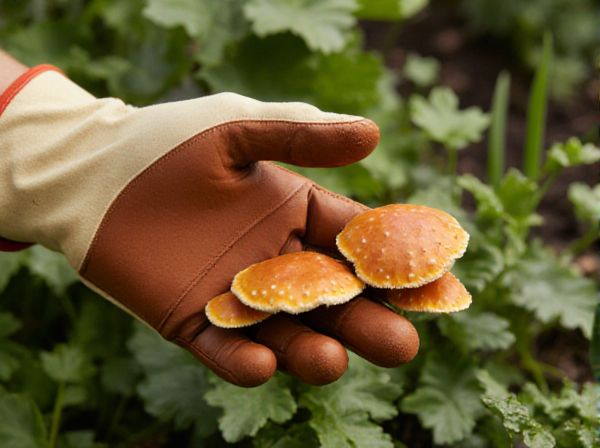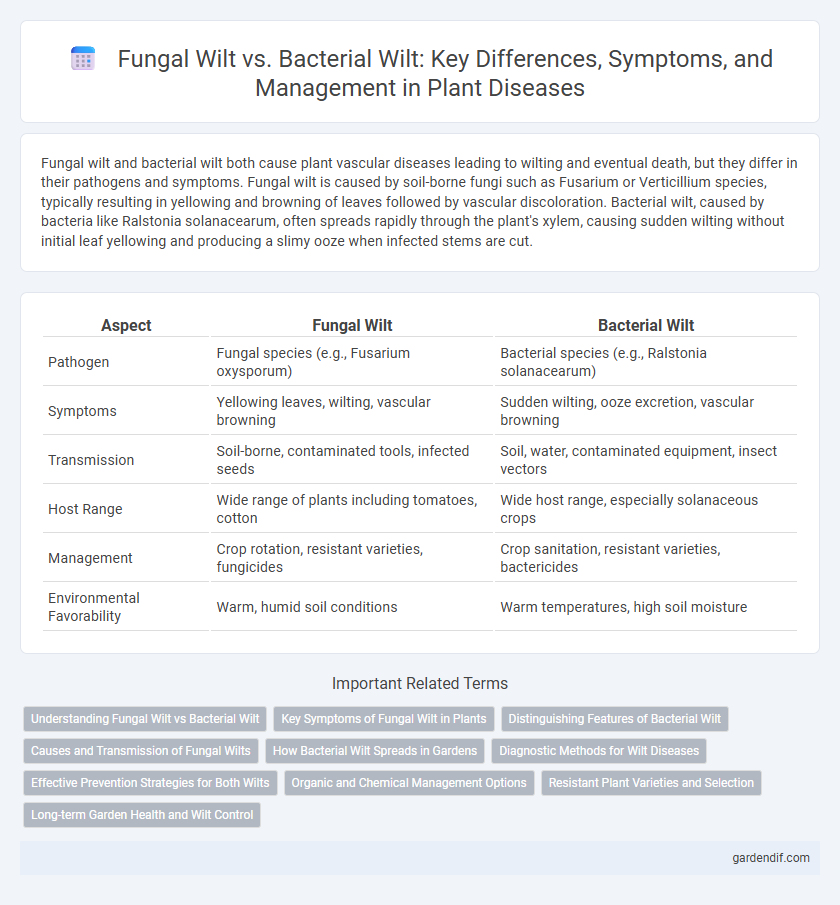
Fungal wilt vs Bacterial wilt Illustration
Fungal wilt and bacterial wilt both cause plant vascular diseases leading to wilting and eventual death, but they differ in their pathogens and symptoms. Fungal wilt is caused by soil-borne fungi such as Fusarium or Verticillium species, typically resulting in yellowing and browning of leaves followed by vascular discoloration. Bacterial wilt, caused by bacteria like Ralstonia solanacearum, often spreads rapidly through the plant's xylem, causing sudden wilting without initial leaf yellowing and producing a slimy ooze when infected stems are cut.
Table of Comparison
| Aspect | Fungal Wilt | Bacterial Wilt |
|---|---|---|
| Pathogen | Fungal species (e.g., Fusarium oxysporum) | Bacterial species (e.g., Ralstonia solanacearum) |
| Symptoms | Yellowing leaves, wilting, vascular browning | Sudden wilting, ooze excretion, vascular browning |
| Transmission | Soil-borne, contaminated tools, infected seeds | Soil, water, contaminated equipment, insect vectors |
| Host Range | Wide range of plants including tomatoes, cotton | Wide host range, especially solanaceous crops |
| Management | Crop rotation, resistant varieties, fungicides | Crop sanitation, resistant varieties, bactericides |
| Environmental Favorability | Warm, humid soil conditions | Warm temperatures, high soil moisture |
Understanding Fungal Wilt vs Bacterial Wilt
Fungal wilt is caused primarily by soil-borne fungi such as Fusarium oxysporum and Verticillium species, leading to vascular tissue blockage in plants and characteristic wilting symptoms. Bacterial wilt, often caused by Ralstonia solanacearum, results in rapid plant wilting due to bacterial invasion and clogging of the xylem vessels. Accurate diagnosis involves laboratory testing and symptom observation to distinguish the pathogen type for effective disease management strategies.
Key Symptoms of Fungal Wilt in Plants
Fungal wilt in plants primarily manifests as sudden leaf yellowing, browning, and wilting, often starting with lower leaves and progressing upward. Vascular discoloration, visible as dark brown streaks inside the stem, is a distinctive symptom indicating fungal invasion. Unlike bacterial wilt, fungal wilt symptoms typically develop more gradually and may include fungal growth or spores on the affected tissues.
Distinguishing Features of Bacterial Wilt
Bacterial wilt is characterized by rapid wilting of plants without yellowing of leaves, caused primarily by Ralstonia solanacearum infecting the vascular system. Unlike fungal wilt, bacterial wilt exhibits brown discoloration inside the stem when cut, and it often leads to a slimy bacterial ooze visible when infected tissue is squeezed. This disease spreads aggressively through soil, water, and infected plant material, making early detection and sanitation critical for management.
Causes and Transmission of Fungal Wilts
Fungal wilt is primarily caused by soil-borne fungi such as Fusarium oxysporum and Verticillium dahliae, which invade plant vascular systems leading to wilting and eventual death. Transmission occurs through contaminated soil, plant debris, and infected seeds, with pathogens entering roots via wounds or natural openings. The fungi survive in soil for extended periods, making crop rotation and soil sterilization key strategies to manage the spread.
How Bacterial Wilt Spreads in Gardens
Bacterial wilt spreads in gardens primarily through soil, contaminated tools, and infected plant debris, often entering plants via wounds or natural openings in the roots. Insects such as cucumber beetles can also serve as vectors, transferring the bacteria from infected to healthy plants. Maintaining proper sanitation and crop rotation helps reduce the spread of Ralstonia solanacearum, the bacterium responsible for bacterial wilt.
Diagnostic Methods for Wilt Diseases
Diagnostic methods for fungal wilt and bacterial wilt primarily rely on laboratory testing, including pathogen isolation on selective media, microscopic examination, and molecular techniques such as PCR for precise identification. Symptom observation alone is insufficient, as both diseases cause wilting and vascular discoloration, necessitating pathogen-specific assays like ELISA for bacterial wilt or qPCR targeting fungal DNA in infected plant tissues. Accurate diagnosis enables targeted management strategies by distinguishing the causal agents of wilt diseases based on molecular, cultural, and serological diagnostic methods.
Effective Prevention Strategies for Both Wilts
Effective prevention strategies for both fungal wilt and bacterial wilt involve crop rotation with resistant varieties to disrupt pathogen life cycles and reduce soil inoculum levels. Soil solarization and proper field sanitation, including removal of infected plant debris, minimize pathogen survival and spread. Implementing well-drained soil conditions and avoiding excessive irrigation limits favorable environments for fungal and bacterial pathogens causing wilt diseases.
Organic and Chemical Management Options
Fungal wilt management includes organic methods such as crop rotation with resistant varieties and soil solarization to reduce pathogen load, alongside chemical treatments using systemic fungicides like thiophanate-methyl to inhibit fungal growth. Bacterial wilt control relies on organic approaches including the use of biofumigants and antagonistic microbes to suppress bacterial populations, while chemical options are limited but may involve bactericides like copper-based compounds applied preventively. Integrating both organic and chemical strategies enhances disease suppression, improves plant health, and reduces reliance on synthetic chemicals for sustainable wilt management.
Resistant Plant Varieties and Selection
Resistant plant varieties play a crucial role in managing fungal wilt and bacterial wilt by minimizing crop losses and reducing the need for chemical treatments. Selection for resistance involves identifying and breeding plants with genetic traits that confer immunity or tolerance to specific pathogens like Fusarium oxysporum in fungal wilt and Ralstonia solanacearum in bacterial wilt. Utilizing resistant cultivars enhances disease control efficiency and promotes sustainable agriculture by ensuring healthier yields and improved plant vigor.
Long-term Garden Health and Wilt Control
Fungal wilt often causes persistent soil-borne infections that can survive for years, necessitating crop rotation and soil solarization to maintain long-term garden health. Bacterial wilt spreads rapidly via water and insects but can sometimes be mitigated through resistant plant varieties and strict sanitation practices. Integrating these control methods ensures comprehensive wilt management, reducing recurrent outbreaks and promoting sustainable garden vitality.
Fungal wilt vs Bacterial wilt Infographic

 gardendif.com
gardendif.com